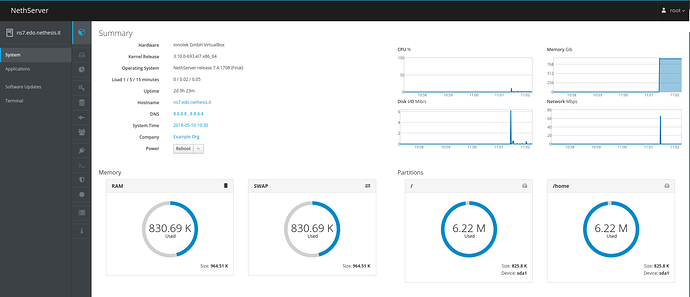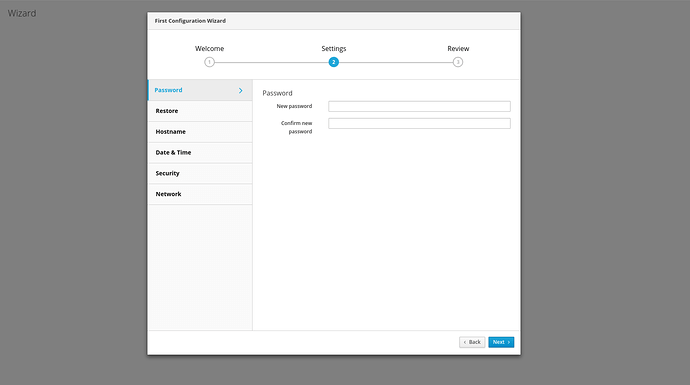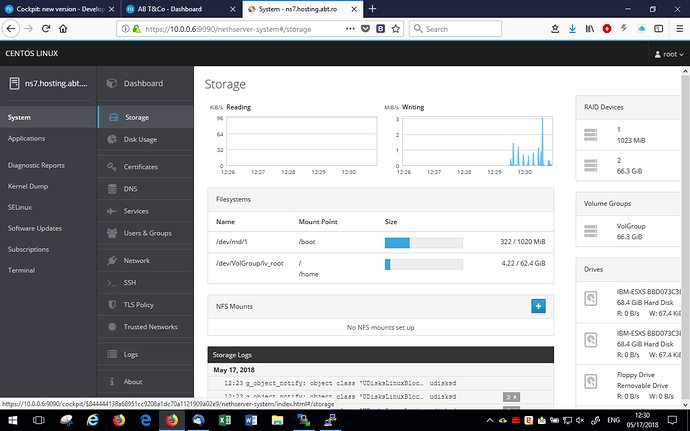Hi guys NethServer Cockpit .
The focus is:
Make the new NethServer modules self-contained as separated apps using the same style and design (the patternfly design).
Implement all functions server-side , it’s possibile to call them directly from terminal, using a CLI for example: nethserver <module> <action>
The interface use those functions to execute actions from GUI directly to the system, as usual
We developed the new version because the previous one had many nasty things:
It uses AngularJS 1.0 (that’s quite old)
All the APIs are implemented via JavaScript, client-side
The System view has cards that are not easily navigable and not in the patternfly standars that instead promote left menu navigation
This new version:
It uses VueJS: that is modern, simple, lightweight and faster than AngularJS
All the APIs are implemented server-side with helpers, that the client calls using cockpit.spawn() as described above
The System has a left menu, fully navigable, and it will be used as a starting point to the next NethServer modules
You can test the new version by installing it from nethserver-testing repository:
yum install -y http://packages.nethserver.org/nethserver/7.5.1804/testing/x86_64/Packages/nethserver-cockpit-0.0.0-1.22.g71d412e.ns7.noarch.rpm
After installation navigate to https://your_server_ip:9090 and enjoy the new interface.
You can also view the First Configuration Wizard , navigate to https://your_server_ip:9090/nethserver-system#/wizard to see it.
It is only a mockup, without functionalities, but it’s used as a demostration of the new interface .
Feedbacks are welcome
Bye
8 Likes
robb
May 17, 2018, 9:33am
2
Any chance on a 7.4 package? (untill all 7.5 modules are stable anyway)
giacomo
May 17, 2018, 9:35am
3
Nope, but you can install also on 7.4 using the above URL
GG_jr
May 17, 2018, 9:39am
4
Installed on 7.4.1708 (Final), updated to CentOS 7.5.1804 (Core) from Software Center.
1 Like
robb
May 17, 2018, 9:42am
5
getting a “noting to update” message:
yum install -y http://packages.nethserver.org/nethserver/7.5.1804/testing/x86_64/Packages/nethserver-cockpit-0.0.0-1.22.g71d412e.ns7.noarch.rpm
But I don’t have the same interface.
Cockpit is an interactive Linux server admin interface.
Do I need to remove the previous version of ns-cockpit?
yes @robb , remove the previous version:yum remove nethserver-cockpit than install the new one
1 Like
AMAZING we’re going to have a shiny future @edoardo_spadoni for your job
1 Like
Ad I said other times, don’t use cockpit.spawn method but use cockpit.http one instead
The spawn method can be dangerous 'cause can executive any arbitrary command (a rm -fr * too) with the privileges of the logged in user.
My 2 €c
1 Like
davidep
May 17, 2018, 8:31pm
10
I found this blog post about cockpit security really interesting
Why .http is safer than .spawn?
This security issue makes me think about NPM dependencies @edoardo_spadoni :
Well… With it you can call and execute only what your API exposes.
davidep
May 17, 2018, 9:11pm
12
IIUC the article says that if the weakness is (in) the browser there’s no API that can protect us. It’s like having an hole in putty/ssh…
We must ensure that any JS code downloaded and executed by our browser is secure, like any Bash Perl and whatever script we run in our shell.
…that’s why NPM dependencies (hell) are critical too
… that’s why we’d like a CLI too, as @edoardo_spadoni said above
Cockpit is a web shell like the bash shell, if you can run rm -rf / on bash, logged as root, you can run also the same command if logged on a web shell, the security problem is not cockpit.spawn.
If someone stole your root’s password, it can runs arbitrary commands from web shell or bash shell…
here we’re not talking about stolen password… if you use .spawn, you’re prone to run arbitrary commands
using .http you strongly limit the possibilities of an attack
in any case, it’s up to you
For the nethserver-cockpit module, we use only this NPM dependecies:
"bootstrap-vue": "^2.0.0-rc.9",
"c3": "^0.5.4",
"d3": "^5.3.0",
"jquery.flot": "^0.8.3",
"moment": "^2.22.1",
"vue": "^2.5.2",
"vue-good-table": "^1.21.0",
"vue-i18n": "^7.6.0",
"vue-resource": "^1.5.0",
"vue-router": "^3.0.1"
at the moment, it seems that they don’t have any security issues.
GitHub is very careful about that, it highlights the vulnerabilities in each packages, if it founds one.
1 Like
davidep
May 18, 2018, 7:21am
16
It’s up on us ! Please help me to understand how .http can be more secure. Do you have any link, article, vulnerability report that explains in which way it is a better approach to security?
well…
.spawn can execute any command available on the shell for the logged in user
for me is a very different approach, 'cause in the second case you have another security layer, your API
giacomo
May 18, 2018, 7:37am
18
Yes for sure:
Every software has its own bug, I don’t see in any of this approaches a security advantage on other.
(Sorry, I couldn’t resist!
1 Like
davidep
May 18, 2018, 7:56am
19
Think about this API example: password change
If the browser has a security hole, or malicious code is injected by other means the attacker can run the API password change and log in, no matter if .spawn or .http is used.
The article I posted above explains this concept far better than me.
We could ask cockpit devs to join this discussion. Next week I’ll post our doubts on their ML. What do you think?
I never said that a REST API is bugless
there’s a slight difference in WP and your product.
WP’s API is exposed and prone to attack
ideally speaking, your API is not… server manager use it, no other can
in any case, as I said, it’s up to you
 ,
, It is only a mockup, without functionalities, but it’s used as a demostration of the new interface.
It is only a mockup, without functionalities, but it’s used as a demostration of the new interface.






